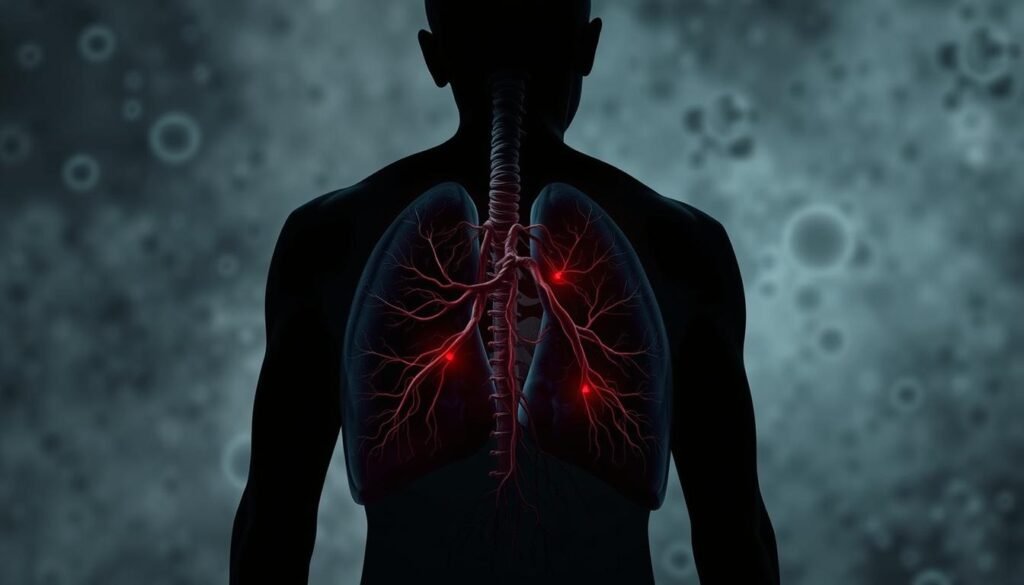Did you know that bone pain is an early sign of lung cancer? This affects 6% to 25% of people. The back is the most common place they feel pain. This shows how back pain can act as an early warning for lung cancer. This is something few people think of right away. Often, back pain is thought to be from muscle strains. Yet, it might be a sign of serious health issues.
Lung cancer can cause tumors to press on the spine or nearby nerves. This leads to unique back pain types. This pain could be a dull ache or sharp, unlike typical back pain. As lung cancer gets worse, so can the pain, especially with metastatic lung cancer.
If you have back pain that won’t go away, see a doctor right away. They can help sort out why. It’s key to also notice other lung cancer signs. These include a cough that stays or losing weight without trying. Spotting these early helps doctors find lung cancer sooner.
Key Takeaways
- Bone pain can indicate lung cancer, especially when located in the spine.
- Approximately 40% of individuals with metastatic lung cancer may experience back pain due to bone metastases.
- Back pain from lung cancer may depend on tumor pressure on spinal nerves.
- Lung cancer-related pain often presents as a dull ache or sharp discomfort.
- Recognizing accompanying symptoms can assist in early diagnosis and treatment.
Understanding Lung Cancer and Its Impact
Lung cancer is a major health issue worldwide. It often goes unnoticed, with symptoms showing up late. Understanding its impact means knowing how it can affect many body parts. It causes problems like back pain for about 25% of those diagnosed.
Lung cancer can spread to other body parts, worsening symptoms. Sometimes, back pain leads to a lung cancer diagnosis. Recognizing symptoms like ongoing coughs, trouble breathing, or coughing blood is key. These signs should prompt a doctor’s visit.
Back pain in patients can come from different causes. It might be due to the cancer pressing on the spinal cord. Or it can stem from high calcium levels from cancer. Knowing these links helps people seek early medical help. This early action can fight the illness better.
Knowing how lung cancer links to back pain is crucial. It leads to better health choices. Treatment for back pain depends on its cause, from medicines to surgeries. Being aware of lung cancer can lead to better patient results and life quality.
Back Pain From Lung Cancer
Back pain from lung cancer can deeply affect a person’s life. It’s important to know why back pain happens. This helps us see how it’s linked to lung cancer getting worse. About 25% of people with lung cancer feel this pain. Sometimes, back pain is the first clue of non-small cell lung cancer (NSCLC).
What Causes Back Pain in Lung Cancer?
Many things cause back pain for lung cancer patients. The main cause is usually cancer spreading to the spine. This creates severe pain. The pain can feel different, from dull aches to sharp, shooting pains.
Also, tumors can press on the spine. This pressure causes spinal cord compression. It leads to pain that can spread to arms and legs. You might feel numb or weak too.
How Tumors Affect the Spine and Nerves
As lung cancer gets worse, especially metastatic lung cancer, tumors can harm areas around the spine. This leads to various back pain symptoms. Leptomeningeal metastasis is another big worry. It’s when cancer reaches the tissues around the spinal cord. This can cause headaches and weakness in limbs.
Cancer spreading to bones can raise calcium levels. High calcium can make pain worse. It can also make you feel nauseous and weak. To understand how bad the back pain is, doctors often use X-rays, CT scans, MRIs, and PET scans. They give useful information about how tumors and the nervous system interact.
| Symptom | Description |
|---|---|
| Back Pain | May be dull or sharp, can radiate to limbs |
| Spinal Metastasis | Cancer spread to spine causing severe discomfort |
| Spinal Cord Compression | Pressure on spinal structures resulting in pain |
| Leptomeningeal Metastasis | Involves cancer spreading to brain and spinal tissues |
| Hypercalcemia Symptoms | Nausea, weakness, and pain due to calcium increase |
Recognizing the Symptoms of Lung Cancer
Knowing the signs of lung cancer early on helps in fighting it effectively. While some don’t show symptoms early, others do.
What to watch for:
- A persistent or worsening cough
- Coughing up blood (hemoptysis)
- Chest pain that worsens with breathing or coughing
- Hoarseness in the voice
- Unexplained weight loss
- Shortness of breath
- Fatigue
- Getting infections often, like bronchitis or pneumonia
- Starting to wheeze when you didn’t before
About half the people with lung cancer have a long-lasting cough. Around 20% cough up blood. Unwanted weight loss happens in 35%-75% of cases.
As the cancer grows, it may spread, causing more symptoms. This includes back pain and issues with the nervous system. Watch out for certain syndromes:
- Horner syndrome: One eye may droop, have a smaller pupil, and sweat less.
- Superior vena cava syndrome: This can make your face and neck swell, cause breathing trouble, and make you dizzy.
- Paraneoplastic syndromes: These mainly affect the nervous or endocrine systems, especially with small cell lung cancer.
It’s hard to pin down lung cancer symptoms because they can overlap with other issues. Back pain alone doesn’t directly point to lung cancer. Always talk to a doctor if you’re concerned. They can help figure out what’s causing your symptoms.
How Back Pain Relates to Lung Cancer Symptoms
Back pain can be a key sign of lung cancer. It is important to recognize cancer-related back pain early. This pain is different from regular back aches.
The Distinct Characteristics of Cancer-Related Back Pain
Cancer-related back pain has unique features. It gets worse at night or when you breathe deeply. Usual pain treatments don’t work well on it. Knowing these distinct characteristics helps in facing health issues early. Early awareness leads to faster medical help and better treatment results.
When Back Pain May Indicate Advanced Disease
Back pain can mean advanced lung cancer sometimes. It may come with weight loss, a constant cough, or other serious cancer symptoms. If you have these symptoms with back pain, see a doctor right away. They could signal a more severe condition needing quick action. For more on how back pain and lung cancer are linked, see this link.
Red Flags: When to Seek Medical Attention
Back pain might be a sign of something serious, like lung cancer. It’s key to know when back pain is just back pain or something more. If you have certain symptoms with your back pain, see a doctor right away to check for severe conditions.
Warning Signs Accompanying Back Pain
If you have back pain, watch for signs that could mean you need a doctor. These symptoms are important:
- Severe back pain occurring at rest or worsening over time
- Pain that gets worse at night
- Unexplained weight loss of 10 pounds or more
- A cough that doesn’t go away or gets worse
- Feeling short of breath, dizzy, or swelling in the face and neck
About 25% of people with lung cancer get back pain at some point. Often, it’s one of the first signs of the disease.
The Importance of Early Diagnosis
Spotting lung cancer early can make a big difference. Waiting too long might mean the cancer gets worse, and treatments won’t work as well. Quick tests and scans can lead to early treatment, which might save lives.
Since 15% of back pains are linked to serious issues like lung cancer, knowing the signs is crucial. If you have these symptoms, talk to a doctor quickly. This can help get you the right treatment and improve your health.
| Warning Sign | Description |
|---|---|
| Severe Back Pain | Back pain at rest or worsening pain in the evening |
| Persistent Cough | Cough that changes or worsens over time |
| Weight Loss | Unexplained weight loss of 10+ pounds |
| Shortness of Breath | Difficulty breathing potentially linked to lung obstruction |
| Swelling in Neck/Face | Noted swelling in the face or neck regions |
Lung Cancer Stages and Associated Back Pain
Metastatic lung cancer is an advanced stage of lung cancer. It spreads from the lungs to other parts of the body, like the spine. The Dana-Farber Cancer Institute says about 25% of lung cancer patients have back pain. This pain is often an early sign before finding out they have cancer. Knowing about this helps with choosing treatments and understanding back pain risks.
Understanding Metastatic Lung Cancer
Finding metastatic lung cancer early is tough because the signs are not obvious. As it gets worse, it can cause many problems. Back pain becomes a big problem for some people. They might not know the pain is because of lung cancer. This is due to other symptoms like chest pain or feeling unwell in general.
Bone Metastases and Their Role in Back Pain
When lung cancer spreads to bones, like the spine, it causes back pain. This can make bones weak and more likely to break, which hurts a lot. Knowing how bone health and lung cancer are connected is important. It helps patients ask for the care they need.
| Stage of Lung Cancer | Common Symptoms | 5-Year Survival Rate |
|---|---|---|
| Stage 1 NSCLC | Often asymptomatic; may include cough, weight loss | 70-90% |
| Stage 2 NSCLC | Coughing, chest pain, fatigue | 50-60% |
| Stage 3 NSCLC | More severe symptoms, including back pain | 35% |
| Stage 4 (Distant Metastases) | Severe back pain, systemic symptoms | 7% |

Pain Management Strategies for Cancer-Related Back Pain
Managing pain from cancer in the back needs a full approach. It involves many meds and therapies. Knowing the options helps patients find what works for them. The aim is to make life better for those under lung cancer treatment.
Medications for Relief
To manage pain, doctors first check the patient’s specific situation and pain type. There are many medication options. These can be:
- Over-the-counter pain relievers like acetaminophen and NSAIDs for slight pain.
- Stronger painkillers, such as opioids, for more intense pain.
- Nerve blocks, which target certain pain spots directly.
- Natural methods like acupuncture and meditation for extra support.
Talking openly with healthcare providers is key. Patients should share how they feel, any side effects, and worries about their meds. A pain rating scale is useful. It shows how bad the pain is, helping doctors make a plan that fits the patient.
Physical Therapies and Rehabilitation
Physical therapy plays a big role in treating cancer back pain. It focuses on rehab through exercises, stretching, and hands-on therapy. These efforts can really ease back pain and improve how well one can move. Following a set exercise plan made by a physical therapist lets patients help in their own recovery.
Using physical therapy alongside other pain management methods leads to better daily life and emotional health. In summary, mixing medications, physical therapy, and open talks with doctors is best for tackling cancer back pain.
| Type of Treatment | Description | Use Case |
|---|---|---|
| Over-the-counter pain relievers | Includes acetaminophen and NSAIDs. | Mild to moderate pain |
| Prescription opioids | Strong meds for serious pain relief. | Moderate to severe pain |
| Nerve blocks | Injecting anesthetic near nerves. | Localized pain control |
| Physical therapy | Specific exercises and rehab methods. | Boosting movement and lessening pain |
| Integrative therapies | Includes acupuncture and meditation. | Extra support and overall health |
Role of Palliative Care in Managing Back Pain
Palliative care plays a vital role in managing back pain for lung cancer patients. It focuses on improving life quality by reducing physical, emotional, and psychological pain. It’s for anyone diagnosed with lung cancer, at any stage.
A team of doctors, nurses, and social workers provides comprehensive symptom management. They are experts in treating back pain caused by cancer. It’s best to discuss palliative care options early in the lung cancer treatment journey.

- Procedures to open airways
- Pain relief medications
- Emotional support
- Nutritional supplements
Palliative care can happen in hospitals, clinics, long-term care facilities, or at home. The team focuses on the patient’s overall well-being. This is key for successful cancer treatment.
Many advanced lung cancer patients do not get early palliative care guidance. This delays the improvement in their quality of life. Including palliative care early in treatment is crucial for handling back pain and other lung cancer symptoms effectively.
Lifestyle Changes to Support Overall Health
Making informed lifestyle changes greatly helps lung cancer patients. Especially those with back pain. Focused on nutritional health and physical activity, these changes can make life better. They also help manage treatment symptoms.
Nutritional Considerations
Good nutrition is key for a strong immune system and better recovery. A diet rich in fruits, vegetables, lean proteins, and whole grains helps. It makes treatment easier to handle. It also reduces side effects like fatigue and pain.
The link between nutritional health and feeling better is strong. It greatly helps overall well-being. Eating well can make treatment more bearable. It helps with issues like nausea, stress, and anxiety too.
Importance of Physical Activity
Regular physical activity improves strength, flexibility, and mental health. Even simple activities like walking or stretching are very beneficial. They offer back pain relief and lessen fatigue. Tailored exercise programs are important. They meet the specific needs of lung cancer patients. This helps people take charge of their health.
Support from family and friends is also crucial. It boosts emotional strength. This, along with exercise, brings great physical benefits.
Oncology Treatment Options for Lung Cancer
People with lung cancer have multiple treatment paths to help them live better and longer. These therapies focus on attacking cancer cells. This helps in managing back pain by lowering the size and impact of tumors.
Surgery is key for treating early lung cancer, also known as non-small cell lung cancer (NSCLC). At stage 0, surgery often fixes the problem alone. Other techniques like photodynamic therapy or laser therapy are also options. For stage I NSCLC, removing part of the lung through surgery might be enough.
As cancer grows, treatments become more complex. Before surgery, chemotherapy, sometimes with immunotherapy, is standard for stage II NSCLC. For patients at stage IIIA, treatments might mix surgery, chemo, and radiation. Treatments for stages IVA and IVB focus on the patient’s unique situation, including how far the cancer has spread and gene changes.
Knowing your treatment options is crucial for wise health decisions. Immunotherapy is notable for boosting the immune fight against cancer. Targeted therapy zeroes in on the cancers’ specific traits.
Treatments aim not just to cure but to make life better. They focus on easing symptoms to improve life quality. This includes managing back pain well, making sure the patient feels supported physically and emotionally throughout their journey.

Overall, knowing all treatment choices helps patients take an active role in their health care. From early steps to advanced treatments, combining methods can make a big difference in managing symptoms and improving outcomes.
| Stage | Treatment Options | Considerations |
|---|---|---|
| Stage 0 | Surgery, PDT, Laser Therapy | Usually curable by surgery alone |
| Stage I | Lobectomy, sleeve resection | Adjuvant therapies may include chemotherapy |
| Stage II | Neoadjuvant chemotherapy | May involve immunotherapy |
| Stage IIIA | Surgery, chemotherapy, radiation | Patient’s health status is critical |
| Stage IIIB | Chemotherapy and radiation | Participation in trials can be beneficial |
| Stage IVA/B | Surgery, targeted therapy, immunotherapy | Treatment tailored to extent of spread |
Conclusion
Knowing how back pain and lung cancer are linked is key for early diagnosis and better treatment. Lung cancer is the top reason people die from cancer around the world. This shows why it’s so important to know about lung cancer.
Having a cough that won’t go away and losing weight without trying are signs that could mean lung cancer. If you have these symptoms with back pain, it’s time to see a doctor.
If your back pain doesn’t stop or if you see other warning signs, you should get help. When cancer spreads to the spine, it can hurt a lot and might mean the lung cancer is getting worse. Getting checked early, using tests like the one for epidermal growth factor receptor, can really help beat the disease.
We need to spread the word about lung cancer signs so people can get help fast. Taking care of both the body and the mind is important for patients. It makes their lives better. Knowing what symptoms to look for is crucial for getting to a doctor in time.
To learn more about how back pain and lung cancer are connected, you can check out this guide. It gives more information.